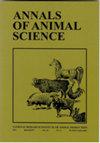Effect of corn gluten meal on the replacement of soybean meal on the survival, biochemical and metabolic responses, and disease resistance of Pacific white shrimp (Litopenaeus vannamei)
IF 1.9
4区 农林科学
Q1 Veterinary
引用次数: 0
Abstract
Abstract This study delves into the potential of replacing soybean meal (SBM) with corn gluten meal (CGM) in the diet of Litopaeneaus vannamei . We aimed to investigate the effects of a dietary soybean meal replacement on various aspects of shrimp, including survival, biochemical indices, digestive enzymes, metabolomics, and disease resistance against Vibrio harveyi . To conduct the study, we fed 840 juvenile Pacific shrimp seven different diets, each containing varying levels of CGM. The control group received a diet with 0% CGM; the other diets contained 3%, 5%, 7%, 9%, 12%, and 14% CGM. Each group comprised three replicates, and the shrimp were fed their diets for eight weeks. Our findings revealed that the survival rate of the shrimp ranged from 90.83% to 97.50% and did not differ significantly between the control and those fed diet treatments 2-5. Additionally, there were no significant differences in crude protein, moisture, and lipid content. However, we observed that total antioxidant capacity content increased with the dietary inclusion of CGM. Furthermore, malondialdehyde content decreased with increasing CGM levels, while superoxide dismutase increased, indicating no obvious oxidative damage was observed in CGM treatment groups. Interestingly, shrimp fed diets 2 and 3 had considerably lower alanine aminotransferase activity than shrimp in the control group. The disease resistance in shrimp was improved across all treatment groups, with a notably higher CGM inclusion having the highest level of mortality during the challenge test. Finally, we analyzed the metabolomics data and found PCA score plots clearly separated the control group and shrimp-fed CGM diets. Our study revealed that a 3% substitution rate of SBM with CGM can enhance survival and immunity, regulate metabolites and improve disease resistance.玉米蛋白粉替代豆粕对凡纳滨对虾(Litopenaeus vannamei)存活、生化代谢及抗病性的影响
摘要本研究探讨了玉米蛋白粉(CGM)在凡纳滨对虾日粮中替代豆粕(SBM)的潜力。我们的目的是研究饲料中豆粕替代对对虾各方面的影响,包括存活率、生化指标、消化酶、代谢组学和对哈维弧菌的抗病性。为了进行这项研究,我们给840只太平洋虾幼虾喂食了七种不同的饲料,每种饲料中含有不同水平的CGM。对照组饲喂添加0% CGM的日粮;其他日粮分别含有3%、5%、7%、9%、12%和14%的CGM。每组设3个重复,饲喂8周。结果表明,各组对虾成活率在90.83% ~ 97.50%之间,对照组与饲粮处理2 ~ 5组间差异不显著。此外,粗蛋白质、水分和脂肪含量无显著差异。然而,我们观察到总抗氧化能力含量随着饲料中添加CGM而增加。丙二醛含量随CGM水平的升高而降低,超氧化物歧化酶升高,说明CGM各处理组未见明显的氧化损伤。有趣的是,饲料2和3的丙氨酸转氨酶活性明显低于对照组。在所有处理组中,对虾的抗病性都得到了改善,在攻毒试验期间,CGM纳入率明显较高,死亡率最高。最后,我们分析了代谢组学数据,发现PCA评分图清楚地将对照组和饲喂CGM饲料的虾区分开。我们的研究表明,用CGM代替3%的SBM可以提高存活率和免疫力,调节代谢产物,提高抗病能力。
本文章由计算机程序翻译,如有差异,请以英文原文为准。
求助全文
约1分钟内获得全文
求助全文
来源期刊

Annals of Animal Science
AGRICULTURE, DAIRY & ANIMAL SCIENCE-
CiteScore
3.80
自引率
5.30%
发文量
138
期刊介绍:
Annals of Animal Science accepts original papers and reviews from the different topics of animal science: genetic and farm animal breeding, the biology, physiology and reproduction of animals, animal nutrition and feedstuffs, environment, hygiene and animal production technology, quality of animal origin products, economics and the organization of animal production.
 求助内容:
求助内容: 应助结果提醒方式:
应助结果提醒方式:


